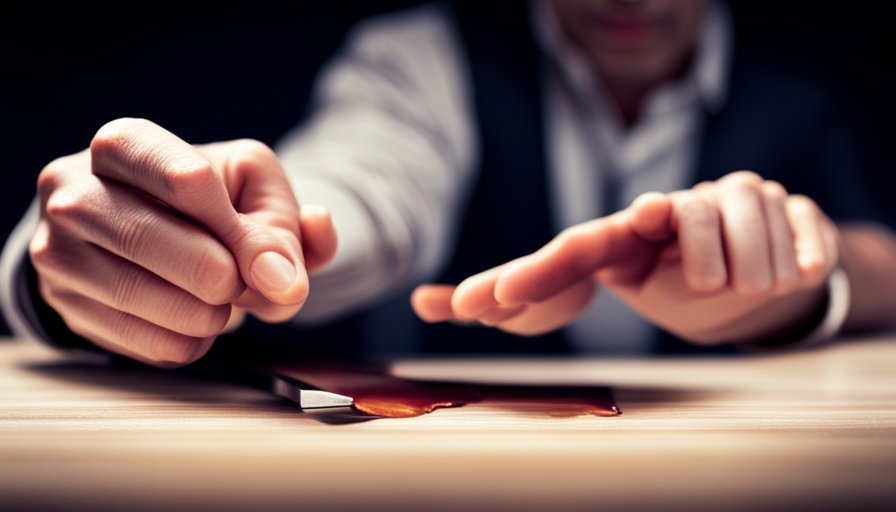Just when you believe you’ve created the ideal ambiance with your beloved scented candles, a disaster occurs. Your lovely wooden furniture is now blemished with unpleasant stains caused by melted candle wax. But have no fear, as I have the answer to this issue.
As an experienced wood enthusiast, I’ve encountered my fair share of wax mishaps, and I’m here to guide you through the meticulous process of removing candle wax from wood.
In this comprehensive article, I’ll share with you my tried and tested techniques for banishing wax stains from your beloved wooden surfaces. From freezing and scraping to applying heat and solvents, I’ll walk you through each step, ensuring that your furniture is restored to its former glory.
Additionally, I’ll reveal some natural remedies and preventive measures to ensure future wax stains are nothing but a distant memory.
So, grab your tools and join me on this journey to reclaim the beauty of your wood. Let’s dive into the world of DIY wax removal and bid farewell to those pesky candle wax stains once and for all.
Key Takeaways
- Assess the damage by examining the affected area for discoloration or changes in texture caused by the wax.
- The freeze and scrape technique is an effective method for removing wax from wood.
- Solvents like rubbing alcohol or mineral spirits can dissolve the wax for easy removal.
- Sanding and refinishing the wood after removing the wax helps to remove any remaining residue and restore the wood’s appearance.
Assess the Damage
Take a good look at the damage caused by that pesky candle wax on your beautiful wooden surface – it’s time to figure out how to make it vanish! As an experienced wood enthusiast, I understand the frustration of dealing with wax stains. Luckily, there are effective methods for assessing the damage caused by candle wax on wood and tips for identifying different types of wax stains on wood surfaces.
To assess the damage, start by examining the affected area closely. Look for any discoloration or changes in texture caused by the wax. Different types of wax, such as beeswax or paraffin wax, may leave different marks on the wood. Beeswax usually leaves a translucent stain, while paraffin wax can create a cloudy or opaque residue. Knowing the type of wax will help you choose the most appropriate removal method.
Now that you’ve assessed the damage, let’s move on to the next step.
Freeze and Scrape
Using the freeze and scrape technique, I’ve found that it’s an effective method for removing stubborn wax from wooden surfaces. However, there are alternative methods that can make this process even easier.
One such method is using a hairdryer to heat the wax and then wiping it away with a cloth. This can be especially useful for smaller areas or delicate wooden surfaces where freezing may not be ideal.
In addition to alternative methods, there are also prevention techniques that can help avoid wax buildup on wooden surfaces. One preventative measure is to use a protective barrier, such as a tablecloth or placemat, when using candles. This will catch any drips or spills and prevent them from seeping into the wood. Regular cleaning and dusting of wooden surfaces can also help to remove any wax residue before it has a chance to build up.
Moving on to the next section about using heat to remove wax, another effective way to remove stubborn wax from wood is by applying heat. This’ll soften the wax, making it easier to scrape off. By using the freeze and scrape technique alongside heat application, you can ensure a thorough removal of wax from your wooden surfaces.
Use Heat to Remove Wax
An effective method for effortlessly eliminating stubborn wax from wooden surfaces involves applying heat, which softens the wax and allows for easy removal. When it comes to using heat to remove wax from wood, there are two common tools that can be utilized: a heat gun or a hair dryer. Both options work by directing hot air onto the wax, causing it to soften and become pliable.
To begin, position the heat gun or hair dryer about six inches away from the wax-covered area. Move the tool back and forth, ensuring even distribution of heat across the wax. As the wax heats up, it’ll start to melt and become more liquid-like. Use a clean cloth or paper towel to carefully wipe away the softened wax.
It’s important to note that excessive heat can damage the wood surface, so it’s crucial to keep the heat gun or hair dryer moving and avoid applying heat for an extended period of time.
With the wax successfully removed, it’s now time to transition into the subsequent section about applying solvents or cleaners to further clean the wood surface. By following this method, you can easily remove wax from wood without any hassle.
Apply Solvents or Cleaners
When dealing with candle wax on wood, one effective method is to apply solvents or cleaners to dissolve the wax. Rubbing alcohol or mineral spirits are commonly used solvents that can break down the wax for easy removal.
However, it’s crucial to test the solvent on a small, inconspicuous area of the wood first to ensure it doesn’t damage or discolor the surface. I’ve found this technique to be highly effective in my experience and it allows for a meticulous and careful approach to removing wax from wood surfaces.
Use a solvent like rubbing alcohol or mineral spirits to dissolve the wax
To easily dissolve the candle wax on your wood surface, grab some rubbing alcohol or mineral spirits and watch as the wax disappears before your eyes. These solvents are highly effective in breaking down the wax and removing it from the wood.
Rubbing alcohol is a common household item that can be easily found in most homes, making it a convenient choice. Mineral spirits, on the other hand, are typically used for more stubborn wax stains.
When using these solvents, it’s important to be cautious and prevent damage to the wood. Avoid scrubbing too vigorously or using abrasive materials that can scratch the surface. Additionally, it’s advisable to test the solvent on a small, inconspicuous area of the wood first to ensure that it doesn’t cause any discoloration or damage.
Test the solvent on a small, inconspicuous area of the wood first
Before applying the solvent, it’s advisable to first test it on an inconspicuous area of the wood. This will ensure that it doesn’t cause any discoloration or damage. Testing the solvent on a small, hidden section of the wood allows you to determine its compatibility with the material. It’s essential to observe any adverse reactions, such as changes in color or texture, before proceeding with the full application.
Additionally, there are alternative methods using household items that you can try if you’re concerned about using solvents. Natural removers like vinegar or baking soda mixed with water can also be effective in removing candle wax from wood. These options provide a safer and more environmentally friendly approach.
Transitioning into the subsequent section about ‘try natural removers,’ it’s important to explore different methods to find the best solution for your specific situation.
Try Natural Removers
For an effective solution, try using natural removers to get candle wax off of wood. Natural removers are a great alternative to chemical solvents and can be just as effective.
When comparing natural versus chemical removers, there are pros and cons to consider. Natural removers are typically safer to use, as they don’t contain harsh chemicals that can potentially damage the wood or pose health risks. However, they may require more time and effort to remove the wax completely. On the other hand, chemical solvents are often quicker and more efficient, but they can be harmful to both the wood and your health if not used properly.
When using natural removers, there are a few options to consider. One popular method is using heat to melt the wax and then wiping it away with a soft cloth. Another option is using a mixture of vinegar and water to dissolve the wax. Simply apply the mixture to the affected area, let it sit for a few minutes, and then wipe it away. You can also use a mixture of baking soda and water to create a paste that can be applied to the wax and gently scrubbed away.
Once the wax has been removed using natural removers, you may notice that the wood has a dull appearance or some discoloration. In the subsequent section, we’ll discuss how to sand and refinish the wood to restore its original beauty.
Sand and Refinish
After using natural removers to remove candle wax from wood, the next step is to sand and refinish the affected area. This process helps to remove any remaining wax residue and restore the wood’s natural shine.
I highly recommend applying a new coat of finish or polish to protect and enhance the wood’s appearance. With my experience and attention to detail, I can assure you that sanding and refinishing will leave your wood looking good as new.
Sand the affected area to remove any remaining wax residue
To truly banish the lingering vestiges of wax, grab some sandpaper and give that affected area a gentle scrub. Sanding the wood is an effective technique for removing any remaining wax residue. Here’s how to do it:
-
Start with a medium-grit sandpaper and sand the affected area in a circular motion. This’ll help to remove any wax that’s still clinging to the wood.
-
Gradually switch to a finer grit sandpaper to smoothen the surface and remove any scratches left by the previous sanding.
-
Use a soft cloth to wipe away the dust created from sanding.
-
If there’re still stubborn wax stains, you can try using the freezing method. Place a plastic bag filled with ice cubes on top of the wax and let it harden. Then, carefully scrape off the hardened wax using a plastic scraper.
-
Finally, once the wax residue is completely removed, you can move on to applying a new coat of finish or polish to restore the wood’s shine.
Now, let’s discuss how to apply a new coat of finish or polish to restore the wood’s shine.
Apply a new coat of finish or polish to restore the wood’s shine
Now, let’s give your wood a fresh and glossy makeover by adding a brand new coat of finish or polish. This step is crucial in restoring the wood’s shine and protecting it from future wax stains.
There are various natural remedies and DIY restoration techniques you can use to achieve this. First, make sure the affected area is clean and free of any residue. Then, choose a high-quality wood finish or polish that matches the color and type of wood you have.
Apply a thin and even coat using a clean cloth or brush, following the manufacturer’s instructions. Allow it to dry completely before applying a second coat if necessary. This will not only enhance the appearance of your wood but also provide a protective layer against future stains.
Moving forward, let’s explore how you can prevent future wax stains from occurring.
Prevent Future Wax Stains
First things first, let’s figure out how to keep those pesky wax stains off our wood surfaces for good! Here are four best practices for preventing future damage and keeping your wood looking pristine:
-
Use protective mats or coasters: Place mats or coasters underneath candles to catch any drips or spills. This will prevent the wax from coming into direct contact with the wood surface.
-
Trim candle wicks: Long wicks can cause candles to produce excessive amounts of soot and smoke, which can settle on nearby surfaces, including wood. By trimming the wicks to a quarter of an inch, you can minimize the chances of wax stains and keep your wood surfaces clean.
-
Opt for flameless candles: Flameless candles provide the ambiance of traditional candles without the risk of wax stains. These battery-operated alternatives eliminate the need for open flames, so you can enjoy candlelight without worrying about wax drips.
-
Clean up spills immediately: Accidents happen, but it’s important to act quickly when wax spills occur. Use a plastic scraper or a credit card to gently remove any excess wax, then follow up with a gentle wood cleaner to remove any residue.
By following these best practices for preventing future wax stains, you can maintain the beauty of your wood surfaces. Now, let’s move on to regular cleaning and maintenance to keep your wood looking its best.
Regular Cleaning and Maintenance
To prevent future wax stains on your wood furniture, regular cleaning and maintenance are essential. It’s important to establish a routine to keep your wood looking its best and minimize the chances of wax buildup.
I’ve found that a gentle dusting with a soft cloth or a microfiber duster is a great first step. This removes any loose dirt or debris that could potentially mix with wax and create a stain. After dusting, I like to use a mild wood cleaner specifically formulated for my furniture. This not only removes any remaining dirt but also nourishes and protects the wood, preventing it from drying out or becoming damaged.
Regular maintenance not only helps in preventing wax stains but also has numerous benefits for your wood furniture. It keeps the wood looking vibrant and polished, enhances its natural beauty, and extends its lifespan. By taking the time to care for your wood furniture, you’re investing in its longevity and ensuring that it remains a cherished part of your home for years to come.
Transitioning into the next section, if you encounter stubborn wax stains that can’t be removed with regular cleaning, it may be time to seek professional help.
Seek Professional Help
If you find that the wax stain on your wood is particularly stubborn or if the wood itself is delicate, it might be best to consult a professional for assistance. They have the expertise and tools needed to effectively remove the wax without causing any damage to the wood.
Professional furniture refinishing services can also be a great option if you want to completely restore the wood’s original beauty, as they have the knowledge and experience to do so with meticulous care.
If the wax stain is stubborn or the wood is delicate, consult a professional
When dealing with a stubborn wax stain on delicate wood, it’s best to seek professional assistance. Professional wood restoration experts have the experience and knowledge to safely remove the wax without causing any damage to the delicate wood surface.
Here are three reasons why consulting a professional is the right choice:
-
Specialized Techniques: Professionals use specialized techniques that are specifically designed to remove wax from delicate wood without leaving any residue or causing any harm.
-
Customized Solutions: They understand that each piece of wood is unique and requires a tailored approach. They will assess the wood’s condition and choose the most suitable method for effective removal.
-
Preservation of Beauty: Professional wood restoration specialists are meticulous in their work. They not only remove the wax but also ensure that the wood’s original beauty is restored.
By entrusting your delicate wood to professional furniture refinishing services, you can be confident that they’ll bring back its original charm and elegance.
Professional furniture refinishing services can restore the wood’s original beauty
You’ll be amazed at how professional furniture refinishing services can breathe new life into the wood, restoring its original beauty and elegance. When it comes to restoring antique furniture, these services are invaluable. They have the knowledge and expertise to handle delicate wood and stubborn wax stains with precision.
The benefits of professional refinishing services are numerous. They have access to high-quality products and tools that can remove even the toughest wax stains without causing any damage to the wood. Additionally, they can also repair any scratches or dents, ensuring that your furniture looks as good as new.
With their meticulous attention to detail and years of experience, these professionals can transform your worn-out furniture into stunning pieces that you’ll be proud to display in your home.
Now, let’s move on to some DIY wax removal tips and tricks.
DIY Wax Removal Tips and Tricks
When it comes to removing wax from wood, I’ve found some additional hacks and techniques that have worked wonders for me. One alternative method is using a brown paper bag to absorb the wax. Simply place the bag over the wax and run a warm iron over it, allowing the wax to transfer onto the paper bag.
Another handy trick is using an iron and paper towel. Just place the paper towel over the wax and apply heat with the iron, causing the wax to melt and transfer onto the towel.
These methods have always been effective for me, and I hope they prove useful to you as well.
Share additional hacks and techniques for removing wax from wood
To tackle candle wax residue on wood, try out these clever hacks and techniques for effortlessly removing it. Here are some alternative methods and natural remedies that I’ve found to be highly effective:
-
Ice: Place ice in a plastic bag and place it on the wax. Once the wax hardens, gently scrape it off with a plastic card or your fingernail.
-
Hot water: Pour hot water over the wax and let it soften. Use a soft cloth to wipe away the residue.
-
Hairdryer: Set your hairdryer to a low heat setting and aim it at the wax. As the wax melts, wipe it away with a cloth.
-
Vinegar: Mix equal parts of vinegar and water, then dampen a cloth with the solution and rub it onto the wax. The wax should dissolve.
-
Baking soda: Make a paste using baking soda and water, apply it to the wax, and let it sit for a few minutes. Scrub it off with a cloth or brush.
These are just a few of the many techniques you can try. In the next section, I’ll provide alternative methods using household items like a brown paper bag or an iron and paper towel.
Provide alternative methods using household items like a brown paper bag or an iron and paper towel
Using common household items like a brown paper bag or an iron and paper towel, I’ve discovered effective methods for removing wax residue from wooden surfaces.
The brown paper bag technique involves placing a brown paper bag over the wax and applying heat from an iron on a low setting. The heat melts the wax, which is then absorbed by the paper bag. It’s important to move the iron in a circular motion and not leave it in one spot for too long to avoid damaging the wood.
Alternatively, you can place a paper towel over the wax and use the iron on a low setting to gently heat the area. The paper towel absorbs the melted wax, leaving the wood clean and free from residue.
These techniques are simple, inexpensive, and can be easily done at home.
Frequently Asked Questions
Can I use a hairdryer to melt the wax and remove it from the wood?
Using a hairdryer to melt candle wax off wood can be effective, but it’s crucial to use caution and keep the hairdryer on a low heat setting. Start by melting the wax with the hairdryer, then gently wipe it away with a cloth. If the hairdryer method doesn’t work, there are alternative methods to consider. For example, you can use an iron with a cloth or freeze the wax and scrape it off.
What type of solvents or cleaners can I use to remove candle wax from wood?
There are alternative methods for removing candle wax from wood without using harsh chemicals. One natural solvent that’s effective is white vinegar. Simply apply a small amount of vinegar to a cloth and gently rub the wax until it lifts off the wood.
Another option is using a hairdryer on low heat to melt the wax, then immediately wiping it away with a cloth.
To prevent wax from getting on your wooden surfaces, place a protective barrier like a tray or coaster underneath the candle.
Is it safe to use a credit card or a plastic scraper to scrape off the hardened wax?
Using a credit card or plastic scraper to scrape off hardened wax is generally safe for wood surfaces. However, it’s important to be cautious and gentle to avoid scratching the wood. Applying heat to the wax can also help soften it, making it easier to remove. Keep in mind that excessive heat can damage certain types of wood, so it’s important to use low heat and test in an inconspicuous area first.
Can I use rubbing alcohol to remove candle wax stains from wood furniture?
Yes, you can use rubbing alcohol to remove candle wax stains from wood furniture. However, I’d recommend using a heat gun as the primary method for removing the wax. The heat gun should be set at a low temperature and held a few inches away from the wax. This’ll melt the wax, allowing you to wipe it away with a clean cloth. Rubbing alcohol can be used as an alternative method if the heat gun isn’t available.
Will sanding and refinishing the wood surface completely remove all traces of candle wax?
Sanding and refinishing the wood surface can be an effective way to remove candle wax, but it may not completely eliminate all traces of it. While sanding can remove the top layers of the wood, it may not penetrate deep enough to remove wax that has seeped into the grain.
It’s essential to use caution and not apply too much pressure while sanding to avoid damaging the wood. Alternatively, there are other methods, such as using heat or using a solvent like mineral spirits, that can also help remove wax from wood surfaces.
Conclusion
After following these steps, I was able to successfully remove the candle wax from my wooden surface. It required careful assessment, freezing and scraping, and the use of heat and solvents.
I also learned about natural removers and the importance of regular cleaning and maintenance to prevent future stains. Seeking professional help is always an option for more stubborn cases.
Remember, just as we can remove wax from wood, we can also remove the burdens that weigh us down in life, revealing the beauty that lies beneath.















